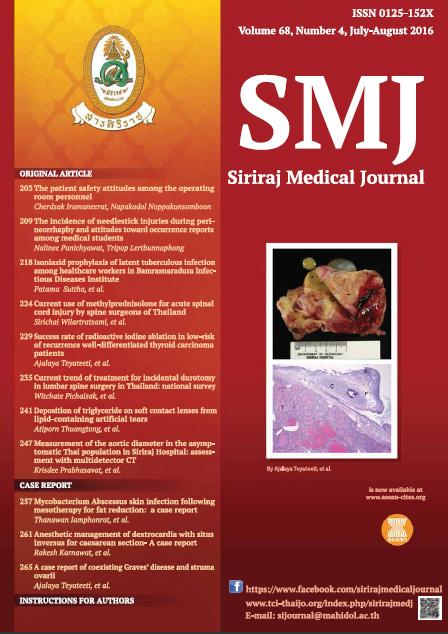Current Trend of Treatment for Incidental Durotomy in Lumbar Spine Surgery in Thailand: National Survey
Keywords:
Incidental durotomy, accidental durotomy, lumbar spine, Thailand, surveyAbstract
Objective: To determine current decision making in treatment for incidental durotomy (ID) in Thailand.
Methods:A questionnaire was sent to all orthopedic surgeons who attended the annual meeting of the Spine Society of Thailand 2016. The questionnaire had 2 parts including demographic data and 15 questions about details of ID repairing technique and postoperative treatment.
Results: Sixty-seven responses were received from 213 participants (31.45% response rate). All respondents were male and performed lumbar spine surgery. Twenty-seven (40.30%) respondents work in a regional hospital. When ID occurred, most of the respondents (87.93%) provided further treatment. Sixty-one percent of respondents preferred prolene. Nylon and silk were used in 20% and 15%, respectively. The preferred size of repairing material was 6-0 (52.23%) and 5-0 (28.36%). The interrupted suture was used in 68.65 percent (46/67). The augmentation included fat graft (29/58, 50%), fibrin glue (12/58, 20.69%) and spongiostan (9/58, 15.5%). Seventy-five percent of respondents (48/64) used vacuum drain and 80% of respondents (54/67) prescribed bed rest after every dural repair. The durations of bed rest were 24 hrs (14/66, 21.2%), 48 hrs (27/66, 40.9%), 72 hrs (16/66, 24.2%) and more than 72 hrs (9/66, 13.6%).
Conclusion:The perioperative management of lumbar ID in Thailand has substantial heterogeneity. Most of the participants prefer using interrupted suture, prolene, 6-0 in diameter, fat graft augmentation and placing wound drainage with vacuum. Duration of best rest varied between 24 to more than 72 hours.
Downloads
Published
How to Cite
Issue
Section
License
Authors who publish with this journal agree to the following conditions:
Copyright Transfer
In submitting a manuscript, the authors acknowledge that the work will become the copyrighted property of Siriraj Medical Journal upon publication.
License
Articles are licensed under a Creative Commons Attribution-NonCommercial-NoDerivatives 4.0 International License (CC BY-NC-ND 4.0). This license allows for the sharing of the work for non-commercial purposes with proper attribution to the authors and the journal. However, it does not permit modifications or the creation of derivative works.
Sharing and Access
Authors are encouraged to share their article on their personal or institutional websites and through other non-commercial platforms. Doing so can increase readership and citations.











